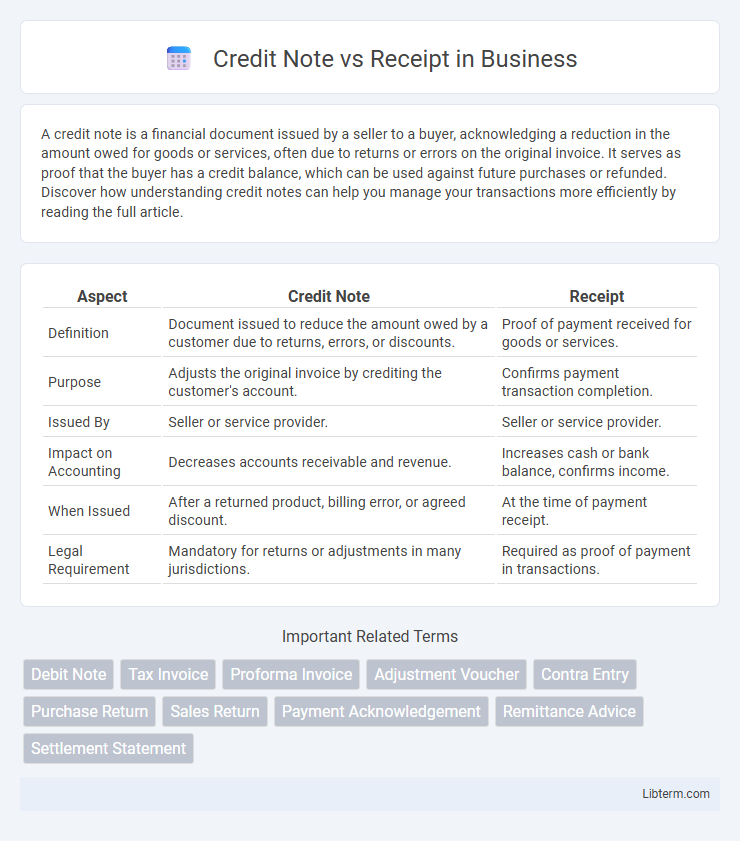A credit note is a financial document issued by a seller to a buyer, acknowledging a reduction in the amount owed for goods or services, often due to returns or errors on the original invoice. It serves as proof that the buyer has a credit balance, which can be used against future purchases or refunded. Discover how understanding credit notes can help you manage your transactions more efficiently by reading the full article.
Table of Comparison
| Aspect | Credit Note | Receipt |
|---|---|---|
| Definition | Document issued to reduce the amount owed by a customer due to returns, errors, or discounts. | Proof of payment received for goods or services. |
| Purpose | Adjusts the original invoice by crediting the customer's account. | Confirms payment transaction completion. |
| Issued By | Seller or service provider. | Seller or service provider. |
| Impact on Accounting | Decreases accounts receivable and revenue. | Increases cash or bank balance, confirms income. |
| When Issued | After a returned product, billing error, or agreed discount. | At the time of payment receipt. |
| Legal Requirement | Mandatory for returns or adjustments in many jurisdictions. | Required as proof of payment in transactions. |
Understanding Credit Notes and Receipts
Credit notes serve as official documents issued to customers when goods are returned or service errors occur, reducing the amount owed on an invoice, while receipts act as proof of payment confirming the completion of a transaction. Understanding the distinct purposes of credit notes and receipts is essential for accurate financial record-keeping and resolving disputes in sales and accounting processes. Businesses rely on credit notes to adjust account balances and maintain transparent customer relations, whereas receipts validate cash flow and support audit trails.
Definition of Credit Note
A credit note is a financial document issued by a seller to a buyer, reducing the amount owed due to returned goods, overbilling, or discounts. It serves as proof of adjustment in the accounts and can be used to offset future purchases or request a refund. Unlike a receipt, which confirms payment, a credit note represents a creditor's acknowledgment of a debt reduction.
Definition of Receipt
A receipt is a formal document issued by a seller to a buyer as proof of payment for goods or services, detailing the transaction amount, date, and items purchased. It serves as evidence of payment and is essential for record-keeping, returns, or warranty claims. Unlike a credit note, which acknowledges a reduction in the amount owed or a refund, a receipt confirms completed payment.
Key Differences Between Credit Note and Receipt
A credit note is issued by a seller to a buyer to acknowledge a return or refund, effectively reducing the amount payable for future transactions. A receipt confirms the payment received by the seller for goods or services delivered, serving as proof of purchase. Unlike receipts, credit notes adjust the buyer's account balance, reflecting changes due to returns, discounts, or allowances.
When to Issue a Credit Note
A credit note should be issued when goods are returned, services are canceled, or an invoice error needs correction, reflecting a reduction in the amount owed by the buyer. It serves as a formal acknowledgment by the seller to adjust the buyer's outstanding balance or future payments, often linked to returned or damaged items. Issuing a credit note ensures accurate accounting records and transparency in financial transactions between businesses.
When to Issue a Receipt
A receipt is issued immediately after a payment is received to confirm the transaction between a buyer and seller, serving as proof of purchase for goods or services. It should be provided at the point of sale, after payment is made in cash, card, or other methods, ensuring both parties have documented evidence of the financial exchange. Receipts are essential for record-keeping, tax purposes, and customer returns or warranty claims, distinguishing them from credit notes, which are issued post-transaction to adjust or cancel amounts owed.
Legal and Compliance Considerations
Credit notes serve as official documentation for adjustments or returns, reflecting a decrease in the amount owed by the buyer and must comply with tax regulations to ensure accurate reporting. Receipts function as proof of payment and are essential for both sellers and buyers to validate transactions and maintain accurate financial records for auditing purposes. Legal compliance mandates that both credit notes and receipts include specific details such as date, amount, parties involved, and transaction references to meet accounting standards and avoid disputes.
Importance in Accounting and Bookkeeping
A credit note is essential in accounting for correcting invoice errors or issuing refunds, ensuring accurate financial records and preventing revenue overstatements. Receipts serve as proof of payment, crucial for validating transactions and supporting expense tracking during bookkeeping. Proper use of both documents enhances financial transparency and compliance with accounting standards.
Common Scenarios for Usage
Credit notes are issued to correct billing errors, return goods, or grant discounts after an invoice has been sent, commonly used when customers return defective products or cancel orders. Receipts serve as proof of payment, issued immediately upon receiving payment for goods or services, frequently used in retail transactions and online purchases. Both documents ensure accurate financial records, but credit notes adjust outstanding balances while receipts confirm completed payments.
Choosing the Right Document for Your Transaction
Credit notes serve to correct or adjust previous invoices by providing a formal record of returned goods or agreed discounts, ensuring accurate account balances. Receipts confirm payment has been received, offering proof of completed transactions for customers and businesses alike. Selecting the appropriate document depends on whether a transaction involves a refund, adjustment, or simple payment acknowledgment.
Credit Note Infographic

 libterm.com
libterm.com